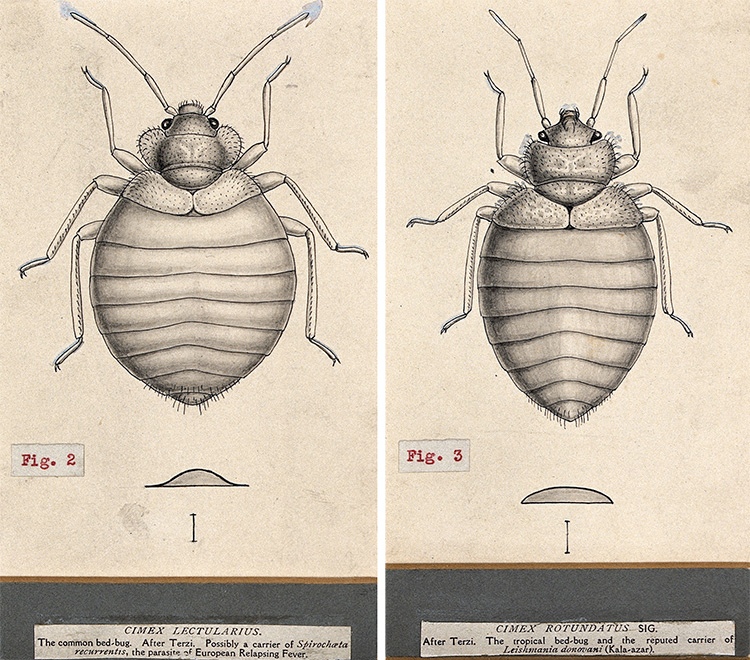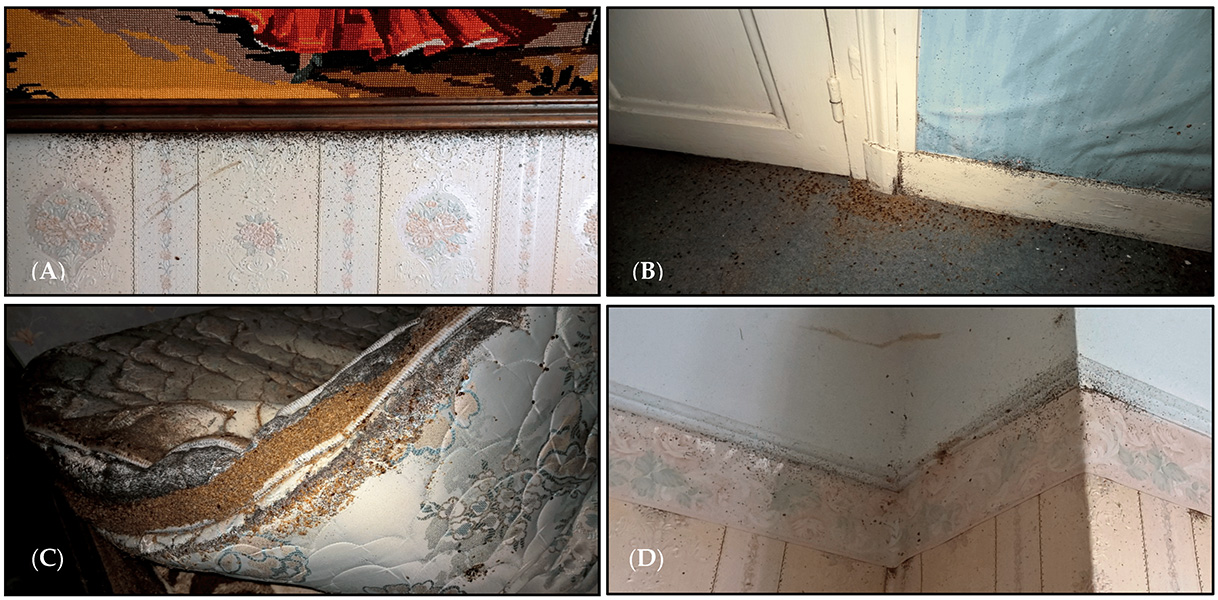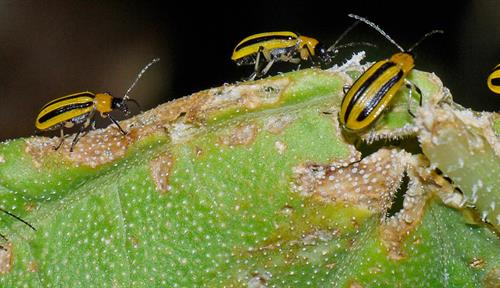The stories have become horribly familiar. Houses so overrun by bed bugs that the bloodsucking insects pile an inch deep on the floor. An airport shutting down gates for deep cleaning after the parasites were spotted brazenly crawling around. Fear and loathing during Fashion Week 2023 in Paris, with bed bug detection dogs working overtime when the insects turned up in movie theaters and trains.
For reasons that almost certainly have to do with global travel and poor pest management, bed bugs have resurfaced with a vengeance in 50 countries since the late 1990s. But recently, the resurgence has brought an added twist. When exterminators swarm out to hunt these pests, they might encounter not just one but two different kinds of bugs.
Besides the common bed bug, Cimex lectularius, which has always made its home in the Northern Hemisphere, there are now sightings of its cousin, the tropical bed bug, Cimex hemipterus, in temperate regions. Traditionally, this species didn’t venture that far from the equator, write entomologists Stephen Doggett and Chow-Yang Lee in the 2023 issue of the Annual Review of Entomology. But in recent years, tropical bed bugs have turned up in the United States, Sweden, Italy, Norway, Finland, China, Japan, France, Central Europe, Spain — “even in Russia, which would have once been unthinkable,” says Lee, of the University of California, Riverside.
Like the common bed bug, the tropical version has grown resistant to many standard pesticides — to the point that some experts say they wouldn’t bother spraying should their own home become infested. It has been estimated that the fight against bed bugs is costing the United States alone $1 billion annually.
This all adds up to a sobering new reality: For many people, bed bugs are becoming a fact of life again, much as they used to be throughout humanity’s history. But as scientists race to find new strategies to combat these pests — everything from microfabrications that entrap the insects to fungal spores that invade and kill them — they also learn more about the often bizarre biology of bed bugs, which might one day reveal the parasite’s Achilles heel.

Side-by-side drawings of the common bed bug (Cimex lectularius, left) and tropical bed bug (Cimex hemipterus, right), by the Italian entomologist and illustrator Amedeo John Engel Terzi, completed around 1919. The geographic range of the tropical bed bug appears to be increasing.
CREDIT: WELLCOME COLLECTION
Hooking up with humanity
Genomics shows that bed bugs emerged 115 million years ago, before the dinosaurs went extinct. When the first humans appeared and moved into caves, the ancestors of today’s bed bugs were ready and waiting. It is thought that these insects initially fed on bats. But bats reduce their blood circulation during their sleeplike torpor state, likely making it harder for the bloodsucking parasite to feed. Presumably, then, at least some bed bug ancestors happily switched to humans.
Since then, the bugs have followed humankind across the globe, tagging along on ancient shipping routes and modern plane rides. Preserved bed bugs were found in the quarters used by workers in ancient Egypt some 3,550 years ago.
Bed bugs can survive a year or more without feeding. About as big as flattened apple seeds, they squeeze into tiny cracks in walls or the joints of bed frames during the day, crawling out at night, attracted by a sleeper’s exhaled carbon dioxide, body warmth and skin odor. In 1900, an estimated 75 percent of homes in the UK contained bed bugs, write Doggett and Lee. Bizarre prescriptions for remedies have circulated down the years, including a recipe for a “cat juice” in a pest control guide from 1725. The formula called for suffocating and skinning a cat, roasting it on a spit, mixing the drippings with egg yolk and oil, and smearing the concoction into crevices around the bed.

Bed bugs have been unwelcome companions of humanity for much of history. This depiction of the creatures comes from a book published in Strasburg in 1536.
CREDIT: WELLCOME COLLECTION
DDT (dichlorodiphenyltrichloroethane) and the pesticides that followed brought a few decades’ worth of respite between the 1940s and 1990s — enough that most people forgot about the insects and didn’t recognize them when they reappeared around the turn of the millennium.
Doggett and Lee hypothesize that the bloodsuckers’ comeback started in areas of Africa, where common and tropical bed bugs naturally coexist and where DDT (and later, other insecticides) were sprayed in bedrooms against malaria-carrying mosquitos. Initially, this would have killed the vast majority of bed bugs, too. But some resistant ones survived and multiplied.
Bed bugs suck up to three times their body weight in blood. As they do, they also take in any viruses or other infectious agents that might circulate in the body of their prey, such as hepatitis B and HIV. They have never been found to transmit these diseases in the wild — but this doesn’t mean that the parasites are benign. “Bed bugs produce some of the most irritating bites of all insects,” says Doggett, of the Department of Medical Entomology at Westmead Hospital in Sydney. “If I receive one, I don’t sleep, as I react so badly. If there are lots of bed bugs, the bites are horrendous.” There have been cases in which people have accidentally set mattresses on fire in desperate attempts to chase the bugs off, sometimes burning down their homes in the process.
Humans aren’t the only ones to react so strongly. The Cimicidae family, to which bed bugs belong, comprises about 100 species. Almost all prefer to bite animals other than humans, often birds. Biologists have observed cliff swallow chicks jumping to their deaths from heavily infested nests rather than enduring the bites.
Extreme infestations, in which hundreds of bugs may descend upon a bed at night, can cause a human sleeper to become anemic. But even just a handful of these pests can lead victims to develop insomnia, anxiety and depression. They may find themselves shunned by friends, blacklisted by landlords and — being sleep-deprived — more prone to car accidents and problems at work.

These photographs were taken in a Paris apartment infested with bed bugs. They show bed bug excretions (dark with digested blood), bed bugs of different life stages, and exoskeleton debris in the baseboards, bed and walls.
CREDIT: M. AKHOUNDI ET AL / DIAGNOSTICS 2023
Indirectly at least, bed bugs probably cause human deaths. Doggett has noticed that some people in Africa are giving up the bed nets that protect them from mosquitos and life-threatening malaria infections because bed bugs hide in them. “In some regions, malaria cases are on the rise, and we think that bed bugs are contributing to this,” he says.
A resistant enemy
By now, bed bug resistance has been reported against most of the prevalent insecticides, including organochlorines, organophosphates, carbamates, neonicotinoids, aryl pyrroles and pyrethroids. Some of today’s bed bug strains tolerate pesticide doses that are many thousands of times higher than those that used to consistently kill them. Resistant bed bugs have either developed gene mutations that prevent pesticides from binding effectively to their cells, or they produce enzymes that quickly break down the toxins in their bodies. Others are growing thicker exoskeletons that the poisons can’t easily penetrate.
An investigation some years back into a hospital in Cleveland discovered that new bed bugs showed up in the facility every 2.2 days on average. And tropical bed bugs seem just as happy in our modern indoors as the common variety. “Heating and air conditioning have made our living environments more standardized,” says Lee. “If a tropical bed bug happens to be introduced to a house in Norway, it can now survive there even in winter.”
Currently, the only bed bug sprays that still tend to work are certain combination products that blend different classes of pesticides. But it’s only a matter of time before these, too, will fail, experts say: Reports of resistance have already been documented. Increasingly, exterminators incorporate nonchemical approaches such as heat treatments, in which trained professionals warm up rooms to above 120 degrees Fahrenheit for several hours. They often sprinkle a floury dust called diatomaceous earth around rooms, which clings to those bugs that hide from the heat in wall cracks or under mattresses. The dust abrades the insect’s exoskeleton, dehydrating it to death.

Desperation down the ages led to sale of many an eradication product, including this one — RIPA, “the king of insecticides,” — advertised around 1900.
CREDIT: WELLCOME COLLECTION
Such measures — combined with more awareness — have helped to plateau, or even partly reverse, the spread of bed bugs in some places. In New York City, for example, bed bug complaints fell by half between 2014 and 2020, from 875 complaints per month to 440, on average. To be sure, that’s still 14 complaints per day.
But while effective, nonchemical methods tend to work slowly. “It’s very common that an elimination takes one to two or even three months,” says Changlu Wang, an entomologist at Rutgers University in New Jersey. Meanwhile, residents must keep living in their infested quarters.
Nonchemical measures may also be expensive since they can require laborious steps such as sealing cracks in walls or physically removing bugs by vacuuming. While a quick (but increasingly futile) spraying of pesticides may cost a few hundred dollars, mechanical eradications can run as high as several thousand. This puts effective bed bug control out of reach of many, making them vulnerable to entrenched infestations that can spread through communities.
The result is that the epidemic has shifted to the poor, says Michael Levy, an epidemiologist at the University of Pennsylvania. “While many cities now have bed bug policies, very few provide much assistance to those who cannot afford treatment,” he says. A 2016 report on 2,372 low-income apartment units in 43 buildings across four New Jersey cities found that between 3.8 percent and 29.5 percent were infested with bed bugs.
The northward spread of tropical bed bugs complicates matters further. Although the two species look alike, tropical bed bugs have more hair on their legs, which allows them to climb out of many of the smooth-walled traps that are used to monitor homes. This means that infestations could stay undetected longer, says Lee. And the larger a population grows, the harder it is to get rid of.
To fight back, researchers find inspiration in traditional wisdom. In Europe’s Balkan region, homeowners used to spread the leaves of a bean plant (Phaseolus vulgaris L.) around their beds. The leaves possess tiny hooks on their surface that trap the bugs. Now a scientist at the University of California, Irvine, is developing a “physical insecticide” in the shape of a synthetic material sporting sharply curved microstructures that mimic those on the bean leaves. These irreversibly impale the feet of the bed bugs, writes UC Irvine’s Catherine Loudon in a 2022 paper in Integrative and Comparative Biology. “The bugs are unable to get away once they are pierced.”
Other recent approaches are also rooted in nature. Scientists have found, for example, that essential oils can repel bed bugs. However, the effect is mostly temporary. Certain fungal spores, on the other hand, work permanently. “Basically, the spores go into the body of the bed bug and kill it,” says Wang. At least one product containing the insect-killing fungus Beauveria bassiana is now available in some markets, including the United States.
Researchers continue to be fascinated by the biology of this insect, particularly its sex life. Although female bed bugs possess a normal set of genitalia, the males typically mate by stabbing a needle-sharp penis straight into the female’s abdomen to inject sperm. They usually do this just after a female bed bug has fed, since this makes her too engorged to protect herself.
Having to cope with these frequent injuries has led female bed bugs to evolve the only immunity organ in the insect kingdom, says Klaus Reinhardt, a zoologist at the Dresden University of Technology in Germany. They have also evolved a remarkably elastic material that covers the parts of their abdomen most likely to be stabbed. “It resembles one of those self-sealing injection bottles that close up again when you pull the needle,” Reinhardt says.
While this knowledge will likely do little to combat these pests directly, answering another question might: Why don’t bed bugs stay on their host’s body like lice do, for example? As it turns out, bed bugs don’t like our smell. Certain lipids in human skin repel the bugs, researchers at the University of Kentucky reported in 2021 in Scientific Reports. This makes them retreat to daytime hiding places, marking their trails with pheromones.
Already, exterminators try to trap bed bugs with fake trail markings. And one day, we might deter the insects from spreading by treating suitcases with smells they despise.
But for now, caution remains the best approach. Experts advise that travelers check accommodations for bed bug defecation stains: on mattress seams, furniture and behind headboards. (The insects poop as frequently as a few dozen times after every blood meal, often right next to their victims.) Suitcases should be kept in the hotel bathtub or wrapped in a plastic bag. Upon arrival back home, the luggage’s contents should be put into the clothes dryer for at least 30 minutes at the highest setting, or into a very cold freezer for several days.
If bed bugs do invade a home, “the biggest mistake is to try and get rid of them on one’s own,” says Doggett. “The average person doesn’t appreciate how challenging it is to control bed bugs and will use supermarket insecticides that are labeled for bed bugs but don’t work. The infestation will spread, and the costs escalate.”
Editor’s note: This article was updated on February 1, 2024, to add Stephen Doggett’s affiliation. Doggett works at the Department of Medical Entomology at Westmead Hospital in Sydney.






